Hedi Lamarr: inventor from Hollywood
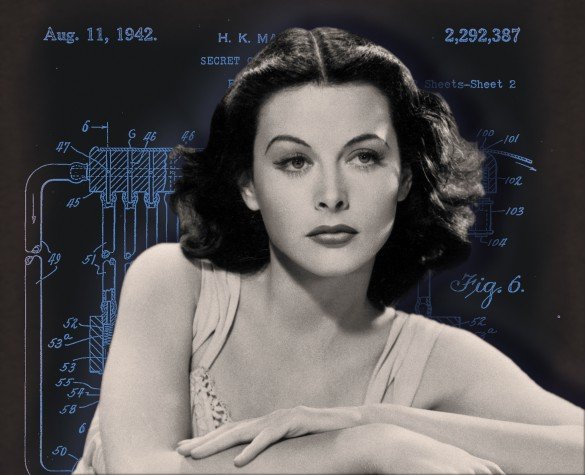
Hedi Lamarr
What is common between playing the piano four hands, torpedoes and wi-fi in your gadget? You will find the answer in this article.
November 9, 2014, the centenary of the birth of Hollywood star Hedy Lamarr was celebrated. Films with her participation have long been a classic of Hollywood. But not everyone knows that she was not just an actress. Without it, we would hardly have talked on a cell phone now, navigated using GPS and searched for where it is better to catch Wi-Fi. But first things first.
Personal life and filming in the cinema
Hedwig Eva Maria Kisler was born in Vienna in 1914 and was the only child in the family of Gertrude and Emil Kisler. Father, Emil Kisler was from Lviv and ran a bank. Mother Gertrude Lichtwitz came from a wealthy Budapest Jewish family and was a pianist.
At the age of 16, Hedwig left home, entered the theater school, and began acting in films. She made her debut in the German film "Girl in a Nightclub" (1930).
In the late 1920s, Max Reinhardt invited her to Berlin as an actress.
World fame brought her the Czechoslovak-Austrian film by Gustav Mahat “Ecstasy” (Eve, 1933). A ten-minute scene of naked bathing in a forest lake is quite innocent by the standards of the 21st century, but in 1933 it caused a storm of emotions.The picture was banned for showing in a number of countries and was released a few years later with censorship notes.

Hedi Lamarr
As a child, Khedi attended theater school, studied ballet, played the piano, and also loved to study mathematics.
After scandalous filming, the parents decided to put an end to their daughter's bohemian life and married the 19-year-old Hedwig to the 33-year-old Austrian millionaire and manufacturer Fritz Mandla, the owner of arms factories.
Mandl made a fortune by selling Germany and Hungary the latest weapons systems in violation of the Treaty of Versailles. Hitler and Mussolini attended the factory's receptions. Young Frau Mandl condemned her husband’s political views.

Shot from the movie Ecstasy
Chatterbox - a find for the spy
Soon Hedy realized that for her husband she was just another profitable acquisition, like a car or a thoroughbred horse. Mandle boasted a beautiful wife in front of business partners and high society.
She traveled with her husband to his factories and even attended production meetings. The partners calmly discussed their affairs, not paying attention to the manufacturer’s wife. After all, how can any actress understand what such serious gentlemen talk about? Meanwhile, the actress, for lack of other intellectual entertainments, listened to all meetings and delved into technical issues. Knowledge of mathematics and an inquiring mind allowed her to understand the essence of the conversation pretty well.
“From childhood, everything around me was interesting,” she said. At that time, Mandla's laboratories worked on the creation of guided weapons of various kinds.Control of torpedoes by wire was not applicable in the aquatic environment, and for this they were looking for the opportunity to use the radio. But experts could not overcome the technological shortcomings of the classic radio broadcast.
If Mandla’s partners could know who exactly and in which country will solve this problem ...
Dream Factory Escape
In the summer of 1937, after four years of unsuccessful marriage, Hedwig Mandl makes a classic escape from the castle, sprinkling a sleeping pill maid.
Well aware of the scale of the impending fascist threat, Hedwig did not dare to remain in Europe and went to New York on the ship Normandy.
And right on the ship, she signed a lucrative contract with Louis Mayer. The memory of the scandalous "Ecstasy" was still fresh, and the name Hedwig Kiesler could cause rejection in the Puritan public of the United States.
On Mayer's advice, she took a pseudonym - Hedi Lamarr (in memory of actress Barbara La Marr, Mayer's former favorite).
In Hollywood, the career of the actress quickly went uphill. She has played in such famous films as Algeria, Lady in the Tropics, Tortilla Flat, The Risky Experiment, and Samson and Delilah.
In total, Lamarr earned $ 30 million from filming, a deafening amount at the time.
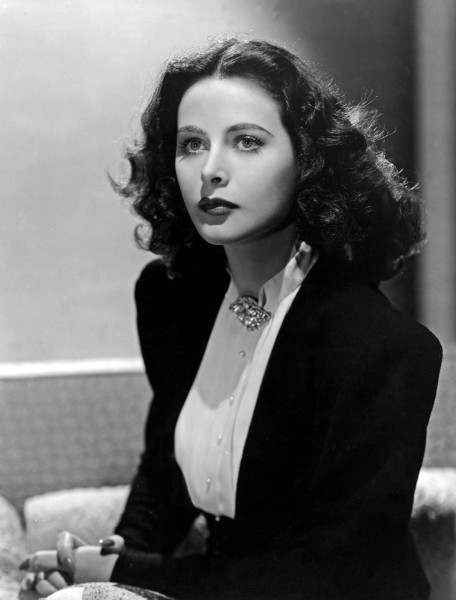
Louis Mayer called Hedi Lamarr the most beautiful woman in the world and thought it was time to break the monopoly of stereotypical platinum blondes on the screen.

Spreading Cranberries: In the movie Comrade X, Hedi Lamarr plays a Soviet wagon driver and even speaks a little Russian
When the Second World War began, the actress turned to the National Council of Inventors of the United States, created as part of measures to strengthen defense capabilities, and offered her services.
True, at first she was recommended to use fame and beauty to sell defense loan bonds. During this promotion, everyone who bought bonds for $ 25 thousand received a kiss from Hedi Lamarr herself. There were many who wanted to, and in this way she raised as much as $ 7 million.
But the actress knew that she could do much more than sell bonds. During this period, in the Atlantic, military and civilian ships perished from attacks by German submarines.
Lamarr recalled how her ex-husband talked with partners about the problem of remote control of torpedoes and the inability to use radio communications for this. If you transmit the coordinates of the target to a controlled torpedo at one frequency, then enemy ships can easily intercept, drown out the signal, or even redirect the torpedo to another target.
Gradually, Hedy came to a simple conclusion: it is necessary to constantly change the frequency randomly over a wide range, synchronizing the transmitter and receiver.
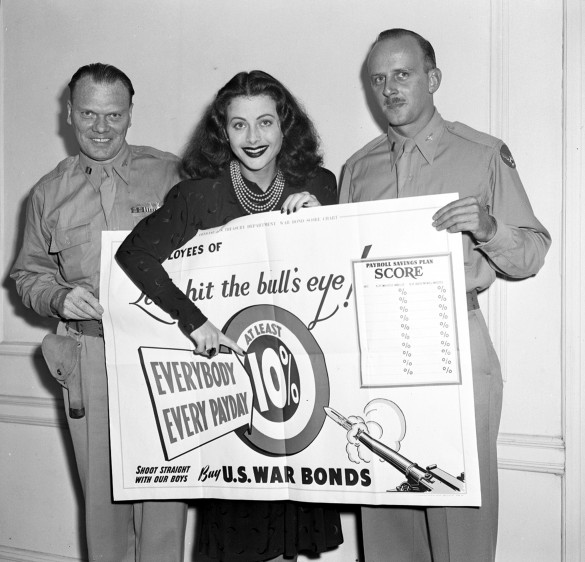
Hedi Lamarr calls: “Shoot accurately with our guys - buy US military bonds”
This idea came to her mind shortly after meeting with avant-garde composer George Antheil (George Antheil, 1900–1959). He was the author of several operas, music for orchestras and films.
One of his most famous works was “Mechanical Ballet” for a symphony orchestra, 12 mechanical pianos, electric bells and an aircraft propeller.
In addition to music, Anteyl wrote several books, worked as a columnist in a magazine, and during the war he acted as a reporter.
In one of the articles, he fairly accurately predicted the development and outcome of World War II.
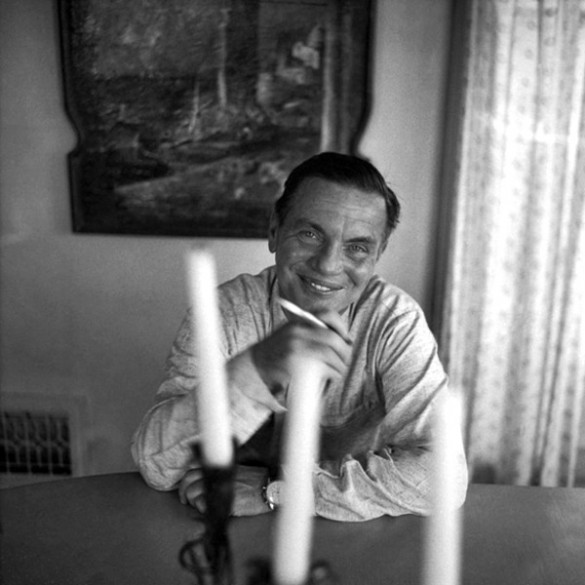
Since childhood, George Anteyle was so obsessed with music that his mother sent him to a village where no one had a piano. However, there he found a way out, ordering the instrument through a music store.
88 keys
Hedy Lamarr met George Anteyle at a party in 1940. At first, they discussed his articles in Esquire magazine, but then the conversation smoothly turned to a topic that occupied both of them: how to help the country in the fight against the Nazis.
Lamarr and Anteyl loved to play the piano four hands. The game led them to the idea that you can send part of the radio signal to a dashboard at one frequency, and then switch to another to transmit the next part of the signal. If the transmitter and the receiver are coordinated in advance with respect to frequency hopping, then the signal can become resistant to jamming interference - it turned out to be like a four-handed game.The mechanical matching of the transmitter with the receiver could occur with the help of a part similar to a beater of a mechanical piano. A compact roller with pins, a perforated tape and a chronometer drive could fit in a marine torpedo hull. The roller began to rotate, setting the course, which is full on punched tape.
A short radio signal transmitted its rotation to the torpedo’s roller, the same perforation automatically filled on it - and the torpedo fired at the heading.
The system could use a set of 88 radio frequencies - the number of piano keys.

Cartoon Announcement: “The Prophet of Mechanisms and Music from Trenton and Paris presents his Mechanical Ballet and other discoveries at Carnegie Hall tomorrow night.”
Pseudorandom codes used to be used to encrypt information, but transmitted over open communication channels. Now, to change the information transmission channels, a secret key was needed, the same for receiving and transmitting. The adversary could not scan and drown out all 88 frequencies, and the calculation would take too much time and effort.
The idea was called the "Frequency Hopping Spread Spectrum". Testing on the mechanical pianos that participated in the production of "Mechanical Ballet" confirmed the system’s performance.A few months later, Hedy and George were finalizing their invention. In December 1940, the application was sent to Charles Kettering, Chairman of the National Council of Inventors (head of the General Motors research department), selected among hundreds of thousands of others and finalized under his leadership.
In June 1941, US Patent No. 2,292,387 was obtained for the Secret Communication System. The patent described secret communication systems, including the transmission of false channels at different frequencies. Lamarr and Anteyl presented it to the government and refused all payments.
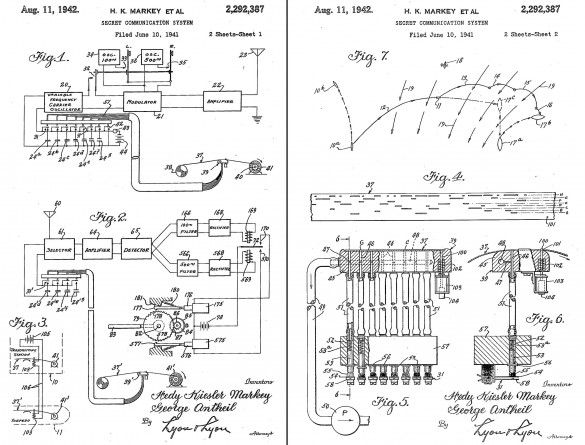
Patent No. 2,292,387, issued to Hedi Kiesler Markey (by the name of the second husband) and George Anteyl
The U.S. Navy tried to implement the plan of inventors in practice, but mechanical control using punched tape was difficult. The patent was classified and put on the shelf for many years.
The concept of frequency hopping revived only with the development of electronics after the war. In 1957, Sylvania engineers began experimenting with the idea of a "secret message system" and using semiconductor components instead of mechanical ones.The term "broadband signal" appeared, and the idea of Lamarr and Anteyla was so fruitful that already in 1962, American troops used new radio equipment during the Cuban crisis.
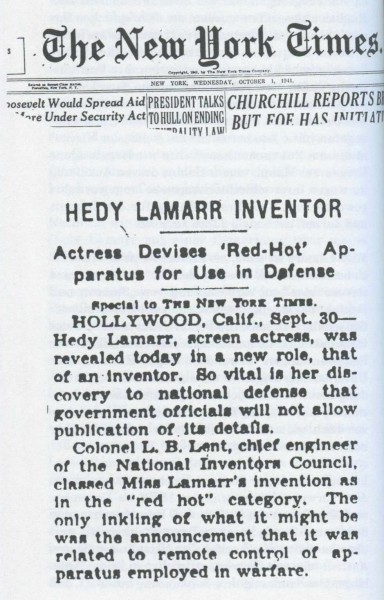
A note in the New York Times about the invention: “Its discovery is so important for national defense that officials will not give permission to publish its details”
In the mid-1980s, the Pentagon declassified a number of patents, and ShPS became available for civilian use. The invention formed the basis of technologies with an extended frequency spectrum, which is used everywhere today: in cellular communications, Wi-Fi, Bluetooth wireless data transfer protocols, in GPS receivers and satellites.
Portrait on the box
In 1953, Hedy Lamarr received American citizenship. She got married six times and had three children. After 1958, she stopped acting, and the last unsuccessful marriage led to the fact that she lost all her fortune.
In 1966, the actress tried to return to the screen, but this was prevented by her inert character and the habit of openly expressing her opinion.
The damage to the reputation of the film star was also caused by charges of theft of things from the store (the court later denied them) and the release of the allegedly autobiographical book Ecstasy and Me, which contained a lot of speculation and gossip.

Hedy with sons Anthony and James and daughter Denise
Wireless computer enthusiasts, digging out the story of Hedi Lamarr, tried to submit it to the IEEE award, but their efforts were unsuccessful. Only in 1997, the actress was awarded the Electronic Frontier Foundation award, but she refused to attend the ceremony and did not want to receive journalists. Her son Anthony Lauder received the award instead.

1966 year. Hedi Lamarr at a press conference the day after his arrest on charges of shoplifting
In 1998, the name Hedi Lamarr again appeared in the media: the actress sued Corel for using her portrait on the package of CorelDraw 8. In the lawsuit, she demanded that she pay $ 15 million, half of them as 10% of CorelDraw's sales 8, and the other half as compensation for non-pecuniary damage.However, the image was not a photograph, but a digital illustration created for the 1996 Corel Design Contest. The illustration received the grand prize, and the company began using it to advertise CorelDraw.
And although Hedi demanded to remove her image from all Corel products, by a court decision, the companies were allowed to use Lamarr's face for five years, and also ordered the actress to be paid $ 250,000.

Artist John Corkery painted this digital illustration of 120 hours
Hedi Lamarr died on January 19, 2000 at the age of 86 in a nursing home. For her contribution to the achievements of cinema, she was awarded a star on the Hollywood Walk of Fame.
In 2014, Lamarr and Anteil were inducted into the National Inventors Hall of Fame.
SOURCE: WIKIPEDIAAnd the actress’s birthday on November 9 is the Day of the inventor in Germany, Austria and several other European countries.
All Articles